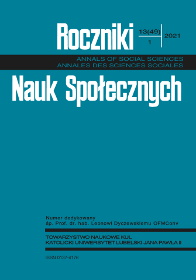Indoor Culture and New Technology
Abstract
Although the restrictions associated with the COVID-19 pandemic significantly reduced or completely eliminated the manifestations of artistic life, human ingenuity and simply necessity made it possible to transfer many offline cultural events and events to the online environment. Free online broadcasts from concerts such as the Berlin Philharmonic, opera performances from the New York Metropolitan, as well as theater and music concerts have gained in popularity worldwide. Film production companies have begun to make films available online. The offer of video or VOD (Netflix, YouTube, Twitch, Showmax, Paramount Play) has increased (Upper, 2020). Because, at least in the first phase of the pandemic, the revenue from the cinemas fell, VOD services could watch hits, e.g. in the United States — Emma, and in Poland — Hejter. Virtual tours were offered by well-known museums, such as the Louvre in Paris and international cultural heritage sites, including the Roman Colosseum. Since the outbreak of the epidemic there has also been a rapid increase in online gaming traffic. Finally, after the total suspension, sports competitions, e.g. football matches, came back, but without the participation of the fans, albeit like stand-ups with played recordings of the stadium’s fans’ reactions. In this way, what we call entertainment or popular culture has been domesticated and is done through the media. In this article I review the possibilities that new technologies now offer for domesticated culture in new circumstances forced by a pandemic COVID-19.
References
Accenture Communications and Media Survey (2020), https://www.accenture.com/_acnmedia/PDF-128/Accenture-COVID-19-Rebuilding-Business-Report.pdf [dostęp: 10.10.2020].
Bachórz A. i in. (2016), Kulturalna hierarchia. Nowe dystynkcje i powinności w kulturze a stratyfikacja społeczna, Gdańsk: Instytut Kultury Miejskiej.
Business Insider Polska (2020), Eksplozja treści wideo stała się faktem również w Polsce. Są wyniki przełomowego badania dot. telewizji i internetu, https://businessinsider.com.pl/media/tv-radio/ogladalnosc-telewizji-i-wideo-w-internecie-badanie-nielsen-media/delhq2j
Carter S. (2018), Przyszłość telewizji? Binge-watching i streaming to tylko początek rewolucji tłum. M. Orłowski, wyborcza.pl, za: The Wall Street Journal, 17 grudnia, https://wyborcza.pl/wiecejswiata/7,163753,24279922,przyszlosc-telewizji-binge-watching-i-streaming-to-tylko.html [dostęp: 25.11.2020].
Colbjørnsen T. (2015), Spotify for… whatever A cross-industrial comparison of streaming services in the media industries, Paper for the fourth International Symposium on Media Innovations, Brussels, June 2, A_Spotify_for_whatever._A_cross-industrie.pdf [dostęp: 12.09.2020].
COVID-19 crisis: Impact on media market (2020), Geneva MIS EBU, https://www.ebu.ch/search?searchTerm=CoVID+10+Impact+on+media [dostęp: 16.11.2020].
Coyle, R. (2000), Digitising the wireless: Observations from an experiment in “Internet Radio”, Convergence. The International Journal of Research into New Media Technologies, nr 6(3), s. 57-75. DOI:10.1177/135485650000600305
DeLys S., Foley M. (2006), The exchange. A Radio-Web Project for Creative Practitioners and Researchers, Convergence: The International Journal of Research into New Media Technologies, nr 12(2), s. 129-135. DOI:10.1177/1354856506066112
Dłużewska E. (2020), Netflix na wojnie, Gazeta Wyborcza, nr 301, s. 18-20.
Eriksson M., Fleischer R., Johansson A., Snickars P., Vonderau P. (2019), Spotify teardown: Inside the black box of streaming music, Cambridge: The MIT Press.
Esport w Polsce (2019), Raport Mobile Institute.
Flew T. (2010), Media globalne, Kraków: Wydawnictwo UJ.
Giga Entertainment. Przyszłość rozrywki w dobie gigabitowego internetu, AI, IoT oraz MEC (2020), nfuture hatalska foresight institute, https://prowly-uploads.s3.eu-west-1.amazonaws.com/uploads/landing_page_image/image/127364/Giga_Entertainment._Przysz%C5%82o%C5%9B%C4%87_rozrywki_w_dobie_gigabitowego_internetu__AI__IoT_oraz_MEC.pdf [dostęp: 15.12.2020].
Górna M. (2020), Hollywood po koronawirusie nie będzie takie samo: gwiazdy stracą blask, serwisy VOD urosną. Co z kinami?, https://wyborcza.pl/7,101707,25867203,hollywood-nie-bedzie-takie-samo-po-koronawirusie-100-lat-temu [dostęp: 20.08.2020].
Iqbal M. (2020), Spotify usage and revenue statistics, Business of Apps, October 30, https://www.businessofapps.com/data/spotify-statistics/ [dostęp: 10.11.2020].
Jakie szanse rozwoju ma e-sport w Polsce (2019), money.pl, https://www.money.pl/gospodarka/jakie-szanse-rozwoju-ma-e-sport-w-polsce-6425107226224257a.html
jd (2020), Polacy spędzają ponad 40 min dziennie na oglądaniu serwisu YouTube, Wirtualnemedia, 20 listopada, https://www.wirtualnemedia.pl/artykul/youtube-w-polsce-ile-czasu-spedzamy-oferta, [dostęp: 12.12.2020].
Kogo słuchamy najchętniej? Spotify prezentuje gusta muzyczne Polaków (2020), 14 października, https://spotify.prowly.com/111831-kogo-sluchamy-najchetniej-spotify-prezentuje-gusta-muzyczne-polakow
Konsumpcja treści online a marketing. Raport (2016), P. Kolenda (red.), Warszawa: Digital Resolution.
KRRiTV (2020), Informacja o podstawowych problemach radia i telewizji, Warszawa: KRRiT.
Kyzioł A. (2020), Nowe radiowe stacje internetowe, Polityka, 27 kwietnia, https://www.polityka.pl/tygodnikpolityka/kultura/1953908,1,nowe-radiowe-stacje-internetowe.read [dostęp: 25.12.2020].
Netflix SWOT Analysis (2020), An In-depth SWOT Analysis of Netflix, https://bstrategyhub.com/swot-analysis-of-netflix-2019-netflix-swot-analysis/
Netflix ponownie zdominował rynek streamingu (2020), bankier.pl, 16 listopada, https://www.bankier.pl/wiadomosc/Netflix-ponownie-zdominowal-rynek-streamingu-8001841.html
Nyre L. (2007), Minimum journalism. Experimental procedures for democratic participation in sound media, Journalism Studies, nr 8(3), s. 397-413. DOI: 10.1080/14616700701276158
Piechota M. (2012), Rozrywka – ujęcia i konteksty, [w:] G. Stachyra, M. Piechota, P. Nowak (red.), Rozrywka w mediach i komunikacji społecznej, Lublin: Wydawnictwo WSPA.
Sabin S. (2018), Most young adults have an appetite for binge-watching shows, Morning Consult, November 6, https://morningconsult.com/2018/11/06/most-young-adults-have-an-appetite-for-binge-watching-shows/ [dostęp: 12.09.2020].
Sensor Tower’s (2020), Data Digest Q4.
Spotify Revenue and Usage Statistics Mansoor IQBAL (2020), https://www.businessofapps.com/data/spotify-statistics/
Szostak P. (2020), Dobry podcast? Kluczowe charyzmatyczna osobowość i pierwsze dwie, trzy minuty, wyborcza.pl, 8 listopada, https://www.google.com/search?client=firefox-b-d&q=Szostak+P.%282020%29++Dobry+podcast%3F+Kluczowe+charyzmatyczna+osobowo%C5%9B%C4%87+i+pierwsze+dwie%2C+trzy+minuty [dostęp: 12.12.2020].
The future of media: A new framework for valuing content (2020), Informes World Economic Forum, https://es.weforum.org/reports/the-future-of-media-a-new-framework-for-valuing-content, [dostęp: 10.09.2020].
The Media, Entertainment and Culture Industry’s Response and Role in a Society in Crisis (2020), White Paper, June 3, World Economic Forum, WEF_Media_Entertainment_ Report_2020.pdf [dostęp: 17.12.2020].
Wojciechowski K. (2020), Jak w pandemii wydajemy pieniądze na kulturę. Więcej czytamy?, wyborcza.biz, 21 listopada, https://wyborcza.biz/biznes/7,147582,26519240,jak-w-pandemii-wydajemy-pieniadze-na-kulture-czytamy-wiecej.html [dostęp: 10.12.2020].
Żołyńska M. (2020), Spotify zbadało gusta muzyczne Polaków. Wiadomo, kogo słuchamy najchętniej, https://www.logo24.pl/Logo24/7,139601,26396277,spotify-zbadalo-gusta-muzyczne-polakow-wiadomo-kogo-sluchamy.html?disableRedirects=true [dostęp: 08.11.2020].
Copyright (c) 2021 Roczniki Nauk Społecznych

This work is licensed under a Creative Commons Attribution-NonCommercial-NoDerivatives 4.0 International License.


